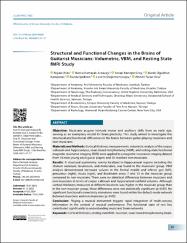Structural and Functional Changes in the Brains of Guitarist Musicians: Volumetric, VBM, and Resting State fMRI Study

View/
Access
info:eu-repo/semantics/openAccessDate
2024Author
Acer, NiyaziArpacay, Burcu Kamasak
Gray, Serap Bastepe
Karapinar, Burak Oguzhan
Ipekten, Funda
Degirmencioglu, Levent
Ilica, Ahmet Turan
Metadata
Show full item recordCitation
Acer, N., Kamasak Arpacay, B., Bastepe-Gray, S., Karapinar, B. O., Ipekten, F., Degirmencioglu, L., & Ilica, A. T. (2024). Structural and Functional Changes in the Brains of Guitarist Musicians: Volumetric, VBM, and Resting State fMRI Study. JOURNAL OF CLINICAL PRACTICE AND RESEARCH, 46(1), 47-57.Abstract
Objective: Musicians acquire intricate motor and auditory skills from an early age, serving as an exemplary model for brain plasticity. This study aimed to investigate the structural and functional differences in the brains between guitar-playing musicians and non-musicians. Materials and Methods: Cortical thickness measurements, volumetric analysis of the corpus callosum and hippocampus, voxel-based morphometry (VBM), and resting-state functional magnetic resonance imaging (fMRI) were applied to a magnetic resonance imaging dataset from 14 male young adult guitar players and 10 matched non-musicians. Results: A structural asymmetry, mainly localized to hippocampal regions including the stratum radiatum, lacunosum, and moleculare, was found in the musicians' group. VBM analysis demonstrated increased volume in the frontal middle and inferior gyri (left), precuneus (right), insula (right), and Brodmann areas 7 and 13 in the musician group compared to non-musicians. There were no statistical differences between musicians and non-musicians in terms of corpus callosum and hippocampal subfield volumes. Although cortical thickness measured at different locations was higher in the musician group than in the non-musician group, these differences were not statistically significant (p>0.05). No significant functional connectivity alterations were found within the default mode network between musicians and non-musicians (p>0.05). Conclusion: Playing a musical instrument triggers rapid integration of multi-sensory information in the context of musical performance. The functional state of rest has contributed significantly to understanding musicians' brain networks.

















